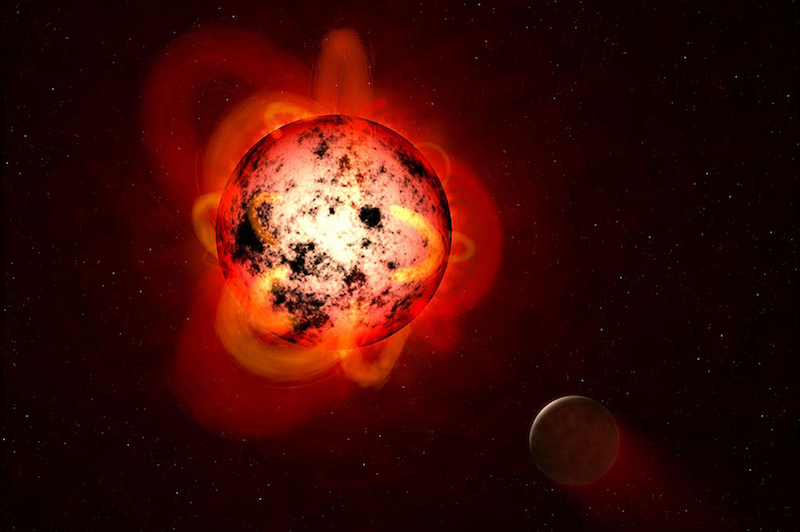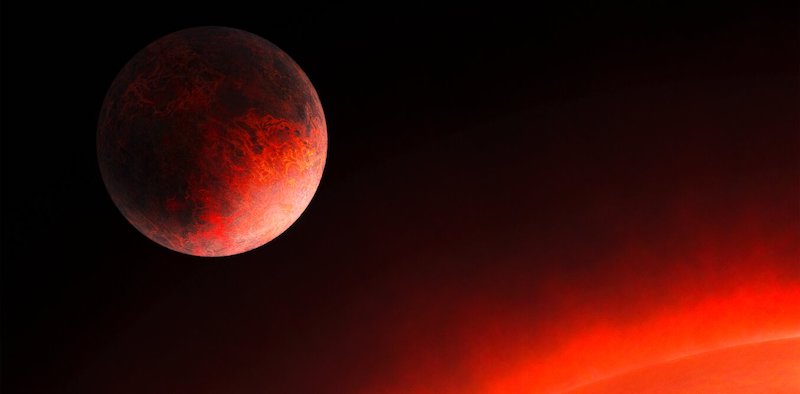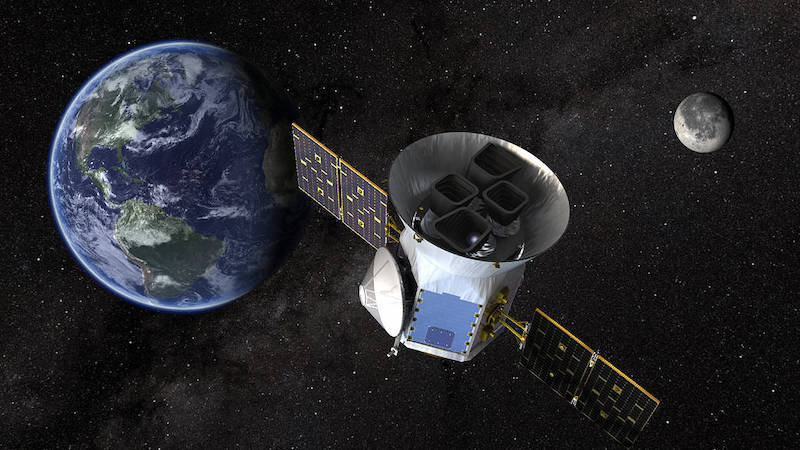
New Mars-sized exoplanet
In our solar system, planets orbit the sun in months or years. The closest and fastest planet, Mercury, takes 88 days to go around the sun once. But astronomers have found exoplanets in distant solar systems that orbit their stars in only hours. Earlier this month (December 2, 2021), researchers announced the discovery of a new planet that orbits its star in only 7.7 hours and is also one of the smallest exoplanets found so far. The planet is labeled GJ 367 b. Intriguingly, it’s about the size of our solar system’s fourth planet Mars, but has a composition similar to that of our sun’s innermost planet, Mercury.
NASA’s TESS planet-hunter discovered the new exoplanet. It’s fairly close by, at only 31 light-years from Earth. The researchers published their peer-reviewed findings about it in the journal Science on December 2. The paper is also available as a free preprint on arXiv.
EarthSky 2022 lunar calendars now available! They make great gifts. Order now. Going fast!
Probably not habitable
Since it’s so close to its star, GJ 367 b is unlikely to be habitable. That is, it likely doesn’t have water on its surface. It probably can’t support life as we know it. The researchers estimate that GJ 367 b receives a whopping 500 times more radiation from its star than Earth does from our sun. In that scenario, it is doubtful that the planet even has any atmosphere left (although that’s not known for sure yet).
Temperatures on the dayside of the planet (since it is likely tidally locked to its star) are estimated to reach around a sizzling 1,500 degrees Celsius (2,700 degrees Fahrenheit).
With all that radiation, scorching temperatures and probable lack of atmosphere, this little world doesn’t sound very hospitable!

Like Mercury on the inside
There are various features that make this world of particular interest to scientists. First, it is what is known as an ultra-short-period planet. The word “period” refers to the length of its orbit around its red dwarf star … in this case, an astonishing 7.7 hours. The planet resembles Mars, with a radius 72% that of Earth and a mass 55% that of Earth.
But the apparent composition of the planet is a surprise. On the inside, GJ 376 b isn’t like Mars or Earth. Instead, it more closely resembles Mercury.
Based on its radius and mass, the researchers think the planet has a solid iron-rich core, with some nickel. Further calculations of the planet’s interior indicate that the core probably accounts for about 86% of the planet’s interior structure. So it’s larger than Earth’s core, percentage-wise, and, in that regard, it’s more like Mercury. Roland Vanderspek, principal research scientist at MIT, confirmed:
We’re finding a Mars-sized planet that has the composition of Mercury. It’s among the smallest planets detected to date, and it’s spinning around an M dwarf on a very tight orbit.
How was GJ 367 b discovered?
Astronomers found the planet in data taken by TESS in 2019. The star, GJ 367, was one of many in a patch of sky in the Southern Hemisphere monitored by TESS.
TESS looks for exoplanets by measuring transits of the planets in front of their stars. This is called the transit method. As the planets pass in front of their stars, as seen from Earth, the starlight dims very slightly. That dimming can be studied to determine if a planet is responsible. GJ 367 b was confirmed as being a real planet and not just a false positive, as sometimes happens.
Later, the researchers also observed the planet’s star using High Accuracy Radial Velocity Planet Searcher (HARPS). HARPS is an instrument on the European Southern Observatory’s telescope in Chile.

Other habitable planets?
While GJ 367 b may be far from an ideal abode for life, there could, however, still be other planets in the system that are habitable. Since a rocky planet like GJ 367 b exists, the researchers think it is possible for there to be other planets in the system as well. According to George Ricker, a senior research scientist at MIT:
For this class of star, the habitable zone would be somewhere near a month-long orbit. Since this star is so close by, and so bright, we have a good chance of seeing other planets in this system. It’s like there’s a sign saying, ‘Look here for extra planets!’
If there are other planets in this system, they could provide clues as to why GJ 367 b ended up orbiting the star so closely. As TESS team member Natalia Guerrero said:
Understanding how these planets get so close to their host stars is a bit of a detective story. Why is this planet missing its outer atmosphere? How did it move close in? Was this process peaceful or violent? Hopefully this system will give us a little more insight.

Bottom line: Astronomers have discovered a nearby blazing hot Mars-sized planet that is more similar to Mercury in composition and orbits its star in only eight hours. It is one of the smallest and lightest exoplanets ever found so far.
Source: GJ 367b: A dense, ultrashort-period sub-Earth planet transiting a nearby red dwarf star
The post A Mars-sized exoplanet, like Mercury on the inside first appeared on EarthSky.
from EarthSky https://ift.tt/3pcIZFB

New Mars-sized exoplanet
In our solar system, planets orbit the sun in months or years. The closest and fastest planet, Mercury, takes 88 days to go around the sun once. But astronomers have found exoplanets in distant solar systems that orbit their stars in only hours. Earlier this month (December 2, 2021), researchers announced the discovery of a new planet that orbits its star in only 7.7 hours and is also one of the smallest exoplanets found so far. The planet is labeled GJ 367 b. Intriguingly, it’s about the size of our solar system’s fourth planet Mars, but has a composition similar to that of our sun’s innermost planet, Mercury.
NASA’s TESS planet-hunter discovered the new exoplanet. It’s fairly close by, at only 31 light-years from Earth. The researchers published their peer-reviewed findings about it in the journal Science on December 2. The paper is also available as a free preprint on arXiv.
EarthSky 2022 lunar calendars now available! They make great gifts. Order now. Going fast!
Probably not habitable
Since it’s so close to its star, GJ 367 b is unlikely to be habitable. That is, it likely doesn’t have water on its surface. It probably can’t support life as we know it. The researchers estimate that GJ 367 b receives a whopping 500 times more radiation from its star than Earth does from our sun. In that scenario, it is doubtful that the planet even has any atmosphere left (although that’s not known for sure yet).
Temperatures on the dayside of the planet (since it is likely tidally locked to its star) are estimated to reach around a sizzling 1,500 degrees Celsius (2,700 degrees Fahrenheit).
With all that radiation, scorching temperatures and probable lack of atmosphere, this little world doesn’t sound very hospitable!

Like Mercury on the inside
There are various features that make this world of particular interest to scientists. First, it is what is known as an ultra-short-period planet. The word “period” refers to the length of its orbit around its red dwarf star … in this case, an astonishing 7.7 hours. The planet resembles Mars, with a radius 72% that of Earth and a mass 55% that of Earth.
But the apparent composition of the planet is a surprise. On the inside, GJ 376 b isn’t like Mars or Earth. Instead, it more closely resembles Mercury.
Based on its radius and mass, the researchers think the planet has a solid iron-rich core, with some nickel. Further calculations of the planet’s interior indicate that the core probably accounts for about 86% of the planet’s interior structure. So it’s larger than Earth’s core, percentage-wise, and, in that regard, it’s more like Mercury. Roland Vanderspek, principal research scientist at MIT, confirmed:
We’re finding a Mars-sized planet that has the composition of Mercury. It’s among the smallest planets detected to date, and it’s spinning around an M dwarf on a very tight orbit.
How was GJ 367 b discovered?
Astronomers found the planet in data taken by TESS in 2019. The star, GJ 367, was one of many in a patch of sky in the Southern Hemisphere monitored by TESS.
TESS looks for exoplanets by measuring transits of the planets in front of their stars. This is called the transit method. As the planets pass in front of their stars, as seen from Earth, the starlight dims very slightly. That dimming can be studied to determine if a planet is responsible. GJ 367 b was confirmed as being a real planet and not just a false positive, as sometimes happens.
Later, the researchers also observed the planet’s star using High Accuracy Radial Velocity Planet Searcher (HARPS). HARPS is an instrument on the European Southern Observatory’s telescope in Chile.

Other habitable planets?
While GJ 367 b may be far from an ideal abode for life, there could, however, still be other planets in the system that are habitable. Since a rocky planet like GJ 367 b exists, the researchers think it is possible for there to be other planets in the system as well. According to George Ricker, a senior research scientist at MIT:
For this class of star, the habitable zone would be somewhere near a month-long orbit. Since this star is so close by, and so bright, we have a good chance of seeing other planets in this system. It’s like there’s a sign saying, ‘Look here for extra planets!’
If there are other planets in this system, they could provide clues as to why GJ 367 b ended up orbiting the star so closely. As TESS team member Natalia Guerrero said:
Understanding how these planets get so close to their host stars is a bit of a detective story. Why is this planet missing its outer atmosphere? How did it move close in? Was this process peaceful or violent? Hopefully this system will give us a little more insight.

Bottom line: Astronomers have discovered a nearby blazing hot Mars-sized planet that is more similar to Mercury in composition and orbits its star in only eight hours. It is one of the smallest and lightest exoplanets ever found so far.
Source: GJ 367b: A dense, ultrashort-period sub-Earth planet transiting a nearby red dwarf star
The post A Mars-sized exoplanet, like Mercury on the inside first appeared on EarthSky.
from EarthSky https://ift.tt/3pcIZFB

Aucun commentaire:
Enregistrer un commentaire